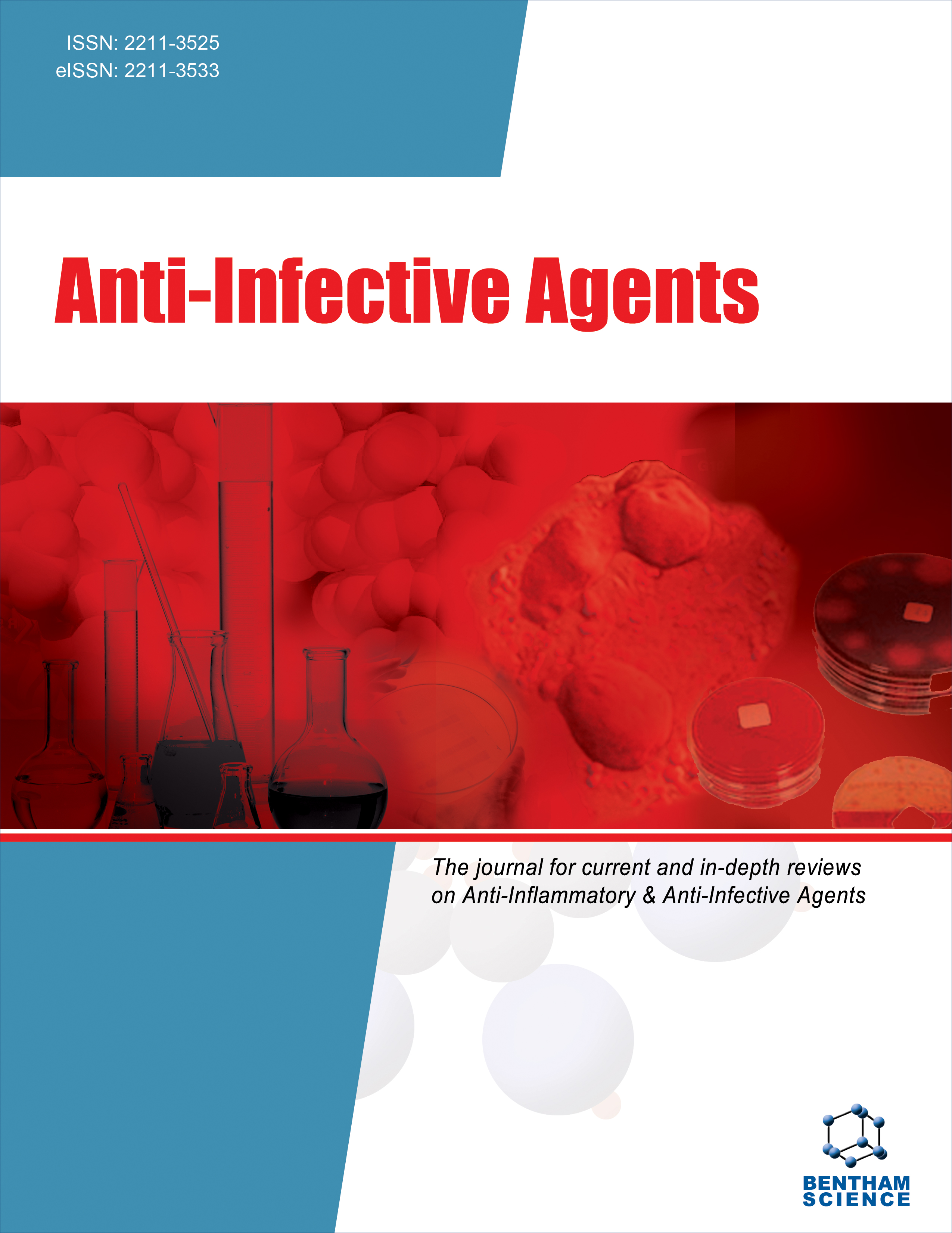- Home
- A-Z Publications
- Anti-Infective Agents
- Previous Issues
- Volume 21, Issue 4, 2023
Anti-Infective Agents - Volume 21, Issue 4, 2023
Volume 21, Issue 4, 2023
-
-
Biological Activities of Papaya (Carica papaya L.) Seed, Rind and Pulp Oil Extracts
More LessAuthors: Aynalem Getahun, Zekeria Yusuf and Mulugeta DestaBackground: Carica Papaya L. is widely cultivated for food and traditional medicine throughout the World due to its rich source of bioactive compounds in its fruit, leaves, latex and stem.Objective: The aim of this work was to assess the physicochemical properties, and antioxidant and antimicrobial activities of oils extracted from papaya seeds, fruit pulp and rind using the solvent extraction method. Methods: Hexane m Read More
-
-
-
Molecular Docking, Multicomponent One-pot Synthesis of Pyrimidine Derivatives as Anti-mycobacterial Agents
More LessBackground: Molecular docking study is used significantly in the drug discovery process for predicting the interaction between drug and receptor. This technique has been used commonly to identify the binding affinity and orientation of drug molecules at the binding site of the target. The main objectives of docking studies include accurate modeling of molecular structure and precise prediction of the biological activity of the dru Read More
-
-
-
Retracted: Analytical Method Development and Validation for Determination of Assay of Antibacterial Drugs Besifloxacin Hydrochloride and Phenoxyethanol in Gel Formulation
More LessAuthors: Pradeep Kundu, Neelam Pawar, Neha Minocha and Asha PooniaThe article entitled “Analytical Method Development and Validation for Determination of Assay of Antibacterial Drugs Besifloxacin Hydrochloride and Phenoxyethanol in Gel Formulation”, by Pradeep Kundu, Neelam Pawar, Neha Minocha and Asha Poonia, published in Anti-Infective Agents 2023; 21(4): e310323215342. https://dx.doi.org/10.2174/2211352521666230331111623. The corresponding author of this article submitted it s Read More
-
-
-
Role of Molnupiravir in the Treatment of COVID-19
More LessAuthors: Aman Sharma, Vaishali M. Patil, Meenakshi Dahiya, Gaurav P. Singh and Anirudh MalikBackground: Molnupiravir is a ribonucleoside analog and exhibits its antiviral mechanism by inhibiting replication. Preclinical studies have been reported that support the role of Molnupiravir towards the prophylaxis, cure, and prevention of SARS-CoV-2 infection. In addition to it, clinical studies have confirmed its activity against the most common variants of SARSCoV- 2.Objective: The manuscript aims to demonstrate th Read More
-
-
-
Anticancer, Antidiabetic and Antimicrobial Activity Study of Biologically Active Vanadium(IV) Mixed Ligand Complexes
More LessIntroduction: Cancer and diabetes are proving to be lethal to human society and have attracted attention of researchers around the world. Synthesis of mixed ligand complexes is a challenging area owing to their potential applications as drugs against various diseases.Methods: Synthesis and biological evaluation of mixed ligand complexes of Vanadium(IV) with heterocyclic bidentate molecule 8-hydroxyquinoline as primar Read More
-
-
-
Comparative Phytochemical Composition and Antimicrobial Activity of Citrus Peel Essential Oils and Phenolic Compounds
More LessBackground: Antimicrobial resistance is imposing an alarming public health threat in regard to the irrational use of the currently available antibiotics and the lack of new antimicrobials.Objective: The current study aims to comparatively investigate the antimicrobial potential and phytochemical compositions of citrus peel essential oils (EOs) and phenolic compounds (PCs) as an approach to combat life-threatening Read More
-
-
-
Therapeutic Potential of Gut Microbiota in Child Health
More LessGut or intestinal microbiota inhabit our body and are well nurtured by the body's ambiance of its preference. Gut microorganisms include bacteria, archae, and fungi that primarily inhabit the digestive tracts of animals. Bacteria like Lactobacillus rhamnosus GG and Bifidobacterium lactis Bb12 have been studied on a wide scale for their potential therapeutic applications. These bacteria are used as probiotics, most often as dieta Read More
-
-
-
A Review of In Vitro Antimicrobial Activities of Carbazole and its Derivative From 2014 to 2022
More LessAuthors: Nitin Kumar, Shalini Sharma and Puneet NirmalA large number of antibiotics are easily accessible for the treatment of various microbial infections. However, antibiotic resistance has become a major concern to public health across the globe. Carbazole derivatives are present in carbazomycins, an unprecedented class of antibiotics showing potential antibacterial activities. As reported in the literature, carbazole derivatives also possess significant antimicrobial activities again Read More
-
Volumes & issues
Most Read This Month
Article
content/journals/aia
Journal
10
5
false
en


